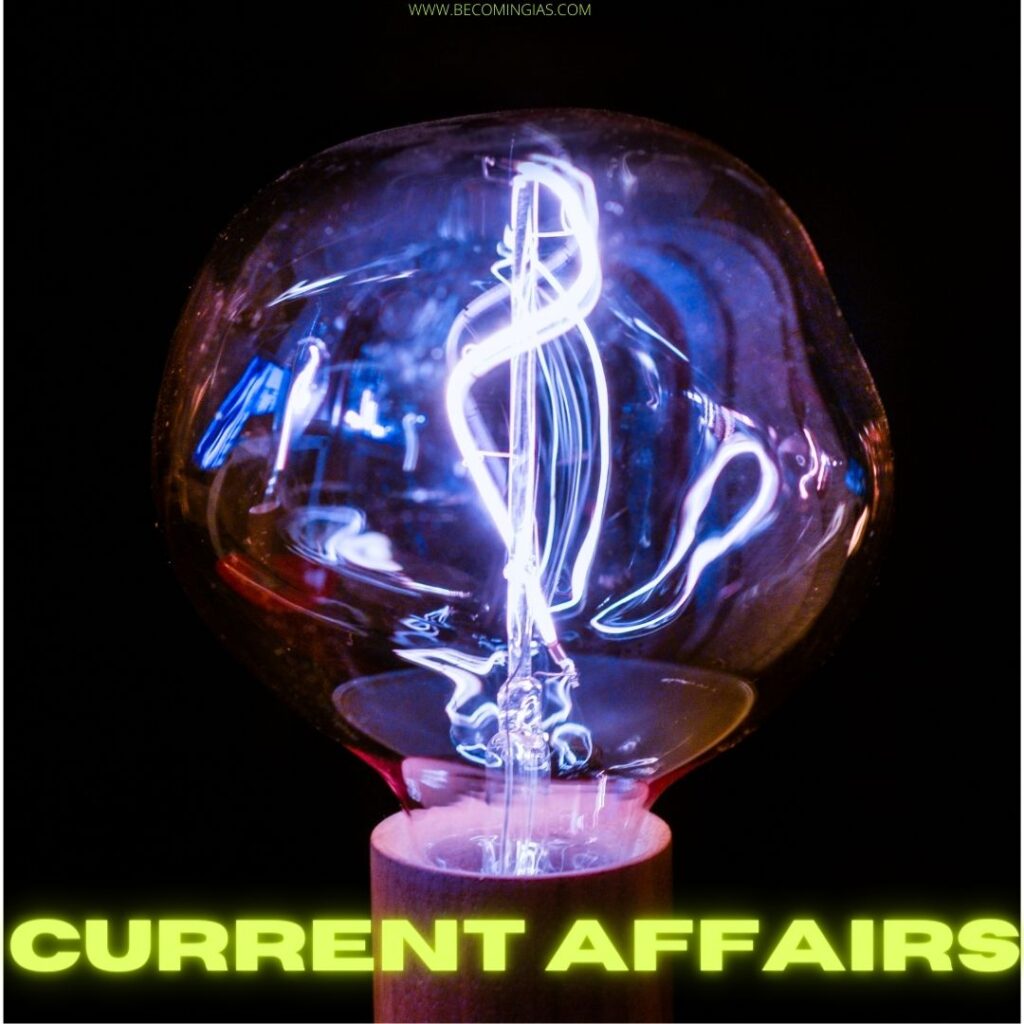It goes without saying that CURRENT AFFFAIRS are hyper-important for the UPSC exam. But it is not always obvious what exactly is meant by ‘Current Affairs’. Almost everything which is happening or has happened in the recent past, and managed to appear in the media somewhere, qualifies as a current affair.

It could be anything from the government launching a new scheme to the price of bitcoin. If all the important flux and change in the world of humanity is Current Affairs, how will you know that you know enough? Or where to start from? Or what to focus on? Or where to read from? Or who to listen to?
This, and some more important insights emerged after I spent a lot of time analysing the previous 10-year question paper for the UPSC exam (both Prelims and Mains) from the point of view of Current Affairs. Here’s what I found-
- Current Affairs Questions are rarely direct- it is not enough to know what was in the news. You must also know the where, why, how, when and what’s next.
- Difficulty level can vary from very easy to very difficult. Mostly hinging towards the difficult side. Difficulty is compounded by the confusing choices in multiple choice questions of Prelims.
- Questions can be factual or conceptual. A single question can be used to test your memory or your conceptual clarity, or both, on a topic.
- There are unlimited sources from which questions can be sourced. No single source can be identified with reliability.
- Many questions of current affairs are indistinguishable from questions of GS. It is unclear where GS ends, and Current Affairs begin. This is much more noticeable in the Mains exam.
- Questions can be multi-disciplinary i: e cutting across disciplines. A single question may simultaneously test your knowledge about the economic, social, or technological background of a topic.
Consider the following questions about crypto-currencies-
Question: The governments of which country/countries have announced the formation of an official crypto-currency? Choose the right options.
- a. China
- b. India
- c. USA
- d. Russia
Choose all the right options
Thoughts: Note that the question is factual. Indirect. It does not ask about the technology behind Bitcoin. To answer this question, you would need to have followed the trend of cryptocurrency as it evolved and the governments response to its rise. These detail may or may not be found in coaching institutes notes.
Question: Which of the following are relevant concerns associated with cryptocurrency? Choose the right options.
- Rise in unauthorized transactions
- Theft, hacking and security issues
- Inflation and over-supply of money in the economy
- Economic Inequality
Thoughts: The question is conceptual. To answer it correctly, you need to know about the ongoing debate and issues regarding crypto currencies. An understanding of this issue will have to be accumulated over time while reading articles or a videos from one or more of the sources. But most importantly, by actually thinking about it. Only then will you be able to confidently eliminate the wrong choices.
No surprise that most UPSC aspirants find current affairs a very challenging portion to prepare for. In this article I suggest that there is a way to cut through all the madness and chaos and to prepare Current Affairs optimally for the UPSC exam.
Problem 1 : Where to prepare current affairs from?
Now with the internet flooded with content, you are constantly bombarded with information from all angles and platforms -from Current Affairs notes, crash courses, magazines, government websites, YouTube Channels, newspapers, apps, and emails in the UPSC-bazar.

The problem with current affairs preparation is not where to prepare from but where NOT to. Your problem is not less choice, but too much choice.
Look at the range of available options of sources available for preparing Current Affairs-
- Newspaper subscriptions like the Hindu, Times of India, Economics Times etc
- Magazines and periodicals such as Yojana
- Current Affairs notes from Coaching institutes like VisionIAS, ForumIAS, InsightIndia etc
- YouTube channels like StudyIQ, GKToday
- Apps like Byjus, Unacademy etc
- Email notifications with weekly updates from content creators, Coaching institutes etc
- Government Websites like PIB, Twitter handles and reports of ministries/departments.
- News Channels like CNN, AajTak etc
- Social Media follows like Nat Geo, Discovery Channel etc on Facebook, Instagram or Qoura
- Groups on Fb, Telegram etc with access to pdf downloads
- Full-fledged Courses from Coaching institutes
- Books from Amazon/Flipkart or offline bookstores
- Your own notes/ saved articles, Screenshots, cut-outs from the newspaper etc
To state the obvious, this is an intimidating list. No one can cover or even should hope to cover it all. What you need is an intelligent filtering mechanism which works for you without compromising on quality. You need content curation instead of more content creations.
Since Current Affairs consists of dynamic content, you will need to learn it continually all through the year, bit by bit.
You can do this intelligently by choosing sources according to mode of consumption. Not all sources of information are textual. Some exist in video format (YouTube) while others may be Audio (Listening to the news) or even imagery (Infographics). This is important because you can consume different types of content at different times of the day and with different receptiveness.
SOURCE FILTER: Limit Current Affairs to a maximum of 3 textual sources and 2 video sources for the entire preparation. Here are the best ones-
The Best TEXTUAL SOURCES for CURRENT AFFAIRS
These include printed notes, books, newspapers etc AND online articles, pdf etc. Be careful not to overload yourself with information. So, choose 2 textual sources ONLY. I suggest 1 being monthly printed notes of Coaching institutes like VisionIAS, ForumIAS etc. These are extensive and cover a wide variety of topics. Your second source of textual current affairs can be digital.
Textual Source 1: VisionIAS, ForumIAS, Insight monthly notes from coaching institutes. Choose ANY ONE which you find best. They all do a good job of compiling content. These notes are extensive and full of densely packed information. The problem with them is that you will not get conceptual clarity about the underlying ideas behind the data which is important for Prelims as much as for Mains. You will have to revise these notes periodically because of the volume of data in each booklet.
Textual Source 2: Choose ONE online source of articles and write-ups which will aid in big-picture formation, opinion-building and add maturity to your understanding of current events. This source may be an app like Flipboard or a digital subscription to the magazine of your choice. Digital articles are preferable because they will add reading time to your total. Resist the urge to waste time on social media and read something which is relevant to the exam AND of interest to you simultaneously. Another advantage is that worthwhile articles can be bookmarked, saved or downloaded for revision later.

Textual Source 3: Google News and regular updates. You will need access to a constantly updated source of headlines and news. For this, Google can be harnessed. You can change the preferences in your Google account for the kind of updates you wish to receive. While setting preferences, remove all political, celebrity and entertainment news which are not relevant for the exam.
The Best VISUAL SOURCES for CURRENT AFFAIRS
Most learning is visual, and the importance of visual learning cannot be overstated. Images, memes, graphics have a much larger imprint on the mind than text. They help in making deeper connections and in ‘anchoring’ your memory to other memories and enhance your knowledge network.
YouTube
Choose only one channel for current affairs which you find to be comprehensive and reliable and make sure to restrict yourself to their videos no matter how tempting other video recommendations appear to be.

Restrict your total watch time to 3 hours/ week for current affairs. This will be enough to accommodate multiple videos which you can accumulate by saving important ones in a separate playlist for revision later. Once a week, take out the time to finish watching your weekly backlog of to-be-watched videos. Set reminders on your phone to remind you of this and track your total weekly watch-time.
Social Media
Contrary to popular belief, social media platforms like Facebook/Instagram are not necessarily a waste of time. If used correctly, they can be potent supplements to your knowledge acquisition efforts for the UPSC exam because this exam is highly dynamic and social media captures this dynamism better than any other media on Earth. The other reason is that content on social media is visual and condensed- it is designed for quick consumption.

It is true that MOST of the content on Social media is useless for you. As a serious aspirant, you should either stay away from social media altogether or figure out a way to use it to your advantage. And this is certainly possible, but the trick is in the details.
Pinterest is a powerful visual platform and source of infographics and so is Instagram but these platforms can be avoided because you will not find core-content for the exam easily. They are also highly addictive and full of distractions.
Facebook can be a powerful platform to filter out the best content in the world, IF and only if, it is used for the content instead of socializing. To do this, follow pages instead of people.
Unfollow everyone in your friend list. This will make sure that your feed is not populated by irrelevant content like honeymoon pictures, celebrity news and birthday wishes. You can turn your Fb feed into an educational content stream by following relevant pages.

Pages worth following should ideally be authoritative, non-commercial, scientific, credible and relevant for the examination. Some pages which I follow and find to be useful for UPSC examination, directly or indirectly are – CNN, Discovery, National Geographic, Kurzgesagt, Cheddar, BigThink, SciShow, The Economist, PopSci, New Scientist, The Ney York Times etc.
Important: Make sure that your Fb use is restricted. Do not follow more than 10 pages. Restrict your surfing time to 1 hour/week. Do not spend more than 10 minutes on an article and read ahead only if you find it relevant. Save only the good ones and make a list of saved articles. Restrict yourself to roughly 7 articles/ posts read each week. Usually, these articles are 12-15 min reads. So, your total reading time should not exceed 2-3 hours/week.
Problem 2: How to use the newspaper for preparation?
You might think that reading the newspaper and taking-notes every day is a good idea but here are 7 reasons why it is not-

- Consider that the average reading speed is about 200 words/min. The amount of information in a newspaper on the front page alone is thousands of words. Consider that a typical newspaper page contains about 5000 words, you will need roughly 25 minutes to cover one page in detail. There are at least a few pages worth reading so your effective reading time exceeds 1-2 hours/ sitting which means 7-10 hours/week. This is a heavy investment of time.
- Before you read the relevant portions from a newspaper, you must first filter through every headline to check if it is pertinent to the exam or not. So, in effect, most of the time you are not ‘reading’ the newspaper as much as scanning it.
- When you do find something worthwhile and wish to save it, you must either cut it out or make notes out of it. However, only a fraction of your saved articles proves to be useful in the end. Moreover, saved newspaper cut-outs are difficult to organise, store and revise.
- Newspapers are neither comprehensive nor exam oriented. Newspapers contain, among other things, political and entertainment news which are not relevant for the exam. Even in current-based topics like Science & technology, you will find that newspapers are selective in the events which they cover and are not comprehensive enough for the UPSC exam. Meaning that even after all the effort you put in day by day, you will always have more current affairs to prepare for.
- You need not update yourself daily. This is because important Current affair events always last longer than a day I: e if you a topic in the news is not repeated more than once, it is probably not worth paying attention to. Everything important gets covered extensively over the course of at least a few days in the media. In other words, the more important the event, the longer it’s shelf-life. So, a weekly or bi-monthly update of current affairs is ideal. At this frequency, unimportant details get filtered out.
- Other sources like coaching institutes cover everything important effectively so your daily-newspaper reading ends up being largely, a double-effort.
- Often editorial articles in newspapers are worth reading but you can find op-ed pieces of much higher quality and variety in other places without all the extra effort. An example is the Flipboard app.

Reading the Newspaper is not useless. But it is also not optimal. It requires a huge investment of energy and time for a return which is relatively too uncertain. It is a Low ROI (return on investment) strategy. If you insist on covering newspapers, make sure to limit your investment according to expected reward, which I think, should not be more than 20 min/day.
It might be a good idea for a beginner to go through the newspaper but as one draws close to the exam, it becomes difficult to justify the enormous investment of time.
While there is merit in daily reading for current affairs for the USPC exam because it is easier to consume smaller chunks of information, using the newspaper as your primary source is likely to add to your challenges instead of making your life easier.
Problem3: How to study current affairs?
Let me remind you that no amount of reading is any good if it does not let you answer questions in the exam correctly. So how much knowledge of current affairs would you need to answer enough questions correctly to qualify the Prelims? The answer is not definable in clear terms.
There is a better way to frame the question- “What is the minimum amount and quality of knowledge which you need to answer enough questions in the exam to qualify?”

This question forces you think the exam in terms of ‘minimum possible effort’ for ‘maximum possible gain’. Start thinking in terms of ROI- Return on Investment. Your primary resource is time, and you get only about 10 waking hours in a day in which to study and work. So, you must reverse engineer the entire challenge and strategize before jumping in. You must think like an investor.
Use the 2 Rules below to maximize ROI for Current Affairs preparation-
RULE 1: Exploit overlaps in the UPSC syllabus
The syllabus of the UPSC exam is overlapping over many areas. You will find topics repeated in Prelims and Mains. So it makes sense to Prepare for Mains and Prelims simultaneously. But sometimes the overlap is not obvious. At times, the overlap is conceptual. Here’s how to optimize-
Leverage optional subjects: Paper 2 of most Optional subjects is India centric and dynamic. Even otherwise, there is usually a portion of the curriculum which is application based and require you to apply theory to practical life. It is useful to keep such topics in mind in mind while preparing Current Affairs.
Use the major events in Current Affairs as opportunities to understand the fundamental concepts of your optional subject. Build insights by thinking about current Affairs as dynamic portion of paper-2 of your optional. Use overlapping current affairs as examples while answer-writing.
Keep an eye on important editorials, mentions and articles which are relevant to your optional subject. Consider the example of the recent farmers protests over the Agricultural Farm Bills in India-

- If your optional subject were sociology, you could interpret the recent farmers agitation in India as class struggle and perhaps use it to enhance your understanding of some foundational theoretical concepts. You might also use news items as relevant examples to use while writing answers for the Optional papers in the Mains exam.
- A student of psychology will find many examples of group dynamics, motivation, leadership etc while covering the farmers protests which is an excellent case study for Social Psychology.
- If your optional subject is economics, you can use the farmer protests as a prime example of the debate between the forced of market economy versus the socialist economic model.
- A student of geography optional will be able to connect the farmers protest to agriculture and to concerns about human geography and social capital.
- A student of history might associate the farmers protests to other peasant uprisings in India and draw comparisons, even insights from comparing the two.
- If you study Political Science, the farmers protests prove to be an excellent of the dynamics of politics and clash of ideologies of power.
- If your optional subject is Philosophy, you will find many parallels from Paper-2 syllabus which includes concepts like justice, liberty, democracy, Gandhian ideology etc.
- A student of Public Administration will find application of these protests in virtually every chapter of the syllabus.
Leverage Ethics Paper
The Ethics paper in the Mains can either be goldmine or a snake-pit. Although it is the subject matter worthy of a book, I suggest going over Previous year Questions and the syllabus to get acquainted with the Paper before diving into Current Affairs.

To illustrate why, consider the farmers protests and image yourself as an administrator facing an ethical dilemma. Ask yourself what kind of ethical debates arise out of every situation. Which values come into conflict with each other? What would your dilemma be, as a police officer or as an IAS officer in charge of the affected area?
While doing so remember that the goal of this exercise is not to seek answers to these problems. The idea here is to think about the questions which you may encounter in the Ethics paper.
Connect to Essay
Essay writing has been explained in extreme detail in the Ultimate Cheatbook of Essay & Answer-writing. Where all of these Rules have been simplified and presented. You will learn how to use current affairs in your Essay but in an entirely different way.
To write brilliant essays, Its not data you need but narrative. Since you will be reading a lot of articles while preparing Current Affairs, notice how the arguments are structured, how facts are used and how the narrative of an essay is built. Pay attention to the structure of the write-up. Notice how the author begins the articles and how they end it. And when you find good ideas, steal them.
I know it is not easy to consider so many angles all the time, but it is helpful to keep in mind that you will have to prepare for the Mains Exam sooner or later. So why not cover as much as possible while simultaneously putting in the effort for Current Affairs? You can and should, exploit overlaps within the entire syllabus. Eliminate double efforts.
RULE 2: Current Affairs = General Studies (CA = GS)
It would be an understatement to say that Current Affairs should be connected to GS. The truth is in fact that Current Affairs IS G.S. This is because the core of your syllabus in the UPSC exam is General Studies. This means that everything exam-related emanates from GS and is connected to GS in one way or another.

Current Affairs is dynamic GS. For a detailed reading of the hidden pattern in General Studies, read this article. This topic deserves an entire book but here’s an example of how Current Affairs are connected to GS.
In GS you study about Macro-economics and centralized currencies. You learn how some governments control the flow of money in an economy by handling the value of their currency. This impact foreign exchange reserves, inflation and a host of important economic indicators. All this is possible only when the government and the banks are in a position to exercise control over these parameters. The government makes fiscal and monetary policies which are implemented via the RBI which then controls the larger supply through various banks. Such centralized systems help regulate the temperature of the Economy. You can think of this system of control as the central cooling mechanism of the human body. You body maintains homeostasis by keeping the temperature stable at 98.6 F. if it gets too cold outside, the body reacts by generating heat by burning more calories via metabolism. If it gets too hot outside, by releasing water via sweat pores. The economy is a bit like that. This is the static portion.

One of the issues with cryptocurrency is that it sidesteps the central regulatory systems of the governments entirely. Two people transacting can exchange mutually agreed upon values etc. by exchanging some digital tokens of promises. Whether the economy remains resilient and this system of exchange gets adopted and the way in which it evolves is for time to reveal.
Cryptocurrency is an example of Dynamic economics. Things evolve and so does money. With cryptocurrency, it is money which is being digitized. There has been enormous interest in blockchain technology because it has the potential to upset entire industries, change the way economies function and maybe even the way in which humans transact with each other.
Another example of CA = GS is the Nobel prizes which are advances in fundamental disciplines. The UPSC expects you to be aware not only of the recipient of the prize and their achievements but the underlying concepts and fundamental basis of their work. Your knowledge must be inter-disciplinary and integrated.
This article covers a vast area of the UPSC exam preparation. What I hoped to communicate is that Current Affairs is not a separate subject deserving isolation. It is connected to everything else. Your job as an aspirant is to understand these connections.
All the best for your preparations!
Ravi Kapoor, IRS


Well I read your article and it’s amazing to see how easy it can be. But for those who are still unable to understand here is a list of Best IAS Coaching in Delhi to go through
Thank you sir ?
A comprehensive platform for social media marketing, SMM Pak Panel provides a wide range of services aimed at increasing online visibility and engagement on several social media platforms. SMM Pak Panel is a practical and effective way for people and companies looking to expand their online presence to include YouTube subscribers and Instagram likes.
GS SCORE- UPSC Paper 2 Syllabus offers a unique challenge with the basket of subjects like Polity & Constitution, Governance & Social Justice and International Relations.GS SCORE presents UPSC Paper 2 Syllabus, a one stop solution to navigate seamlessly through this complex course as it lays stress on concept building, elevating the knowledge and exam readiness of our students through detailed sessions covering the entire syllabus.Visit our website for more info!!
Respected Sir me ak Hindi meadiam ki student hu or sare updates or sari details English me hone k karan mujhe samjhane me bahut time lgta he so please sir, Hindi meadiam students k liye details or updates Hindi me kr dijiye please…?
It’s very useful for me develop my knowledge and acquired my knowledge.